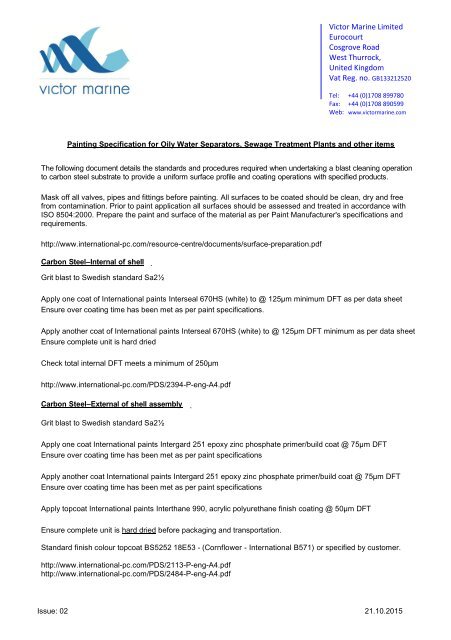Separator Bible
Create successful ePaper yourself
Turn your PDF publications into a flip-book with our unique Google optimized e-Paper software.
Interseal ® 670HS<br />
Surface Tolerant Epoxy<br />
Surface<br />
Preparation<br />
The performance of this product will depend upon the degree of surface preparation. The surface to be coated<br />
should be clean, dry and free from contamination. Prior to paint application all surfaces should be assessed<br />
and treated in accordance with ISO 8504:2000.<br />
Accumulated dirt and soluble salts must be removed. Dry bristle brushing will normally be adequate for<br />
accumulated dirt. Soluble salts should be removed by fresh water washing.<br />
Abrasive Blast Cleaning<br />
For immersion service, Interseal 670HS must be applied to surfaces blast cleaned to Sa2.5 (ISO 8501-1:2007)<br />
or SSPC-SP10. However, for atmospheric exposure best performance will be achieved when Interseal 670HS<br />
is applied to surfaces prepared to a minimum of Sa2.5 (ISO 8501-1:2007) or SSPC-SP6.<br />
Surface defects revealed by the blast cleaning process, should be ground, filled, or treated in the appropriate<br />
manner.<br />
A surface profile of 50-75 microns (2-3 mils) is recommended.<br />
Hand or Power Tool Preparation<br />
Hand or power tool clean to a minimum St2 (ISO 8501-1:2007) or SSPC-SP2.<br />
Note, all scale must be removed and areas which cannot be prepared adequately by chipping or needle gun<br />
should be spot blasted to a minimum standard of Sa2 (ISO 8501-1:2007) or SSPC-SP6. Typically this would<br />
apply to C or D grade rusting in this standard.<br />
Ultra High Pressure Hydroblasting/Abrasive Wet Blasting<br />
May be applied to surfaces prepared to Sa2.5 (ISO 8501-1:2007) or SSPC-SP6 which have flash rusted to<br />
no worse than Grade HB2.5M (refer to International Hydroblasting Standards) or Grade SB2.5M (refer to<br />
International Slurry blasting Standards). It is also possible to apply to damp surfaces in some circumstances.<br />
Further information is available from International Protective Coatings.<br />
Aged Coatings<br />
Interseal 670HS is suitable for overcoating a limited range of intact, tightly adherent aged coatings. Loose or<br />
flaking coatings should be removed back to a firm edge. Glossy finishes may require light abrasion to provide<br />
a physical ‘key’. See Product Characteristics section for further information.<br />
Application Mixing Material is supplied in two containers as a unit. Always mix a complete unit in the<br />
proportions supplied. Once the unit has been mixed it must be used within the<br />
working pot life specified.<br />
(1) Agitate Base (Part A) with a power agitator.<br />
(2) Combine entire contents of Curing Agent (Part B)<br />
with Base (Part A) and mix thoroughly with power agitator.<br />
Mix Ratio<br />
5.67 parts : 1.00 part by volume<br />
Working Pot Life 10°C (50°F) 15°C (59°F) 25°C (77°F) 40°C (104°F)<br />
5 hours 3 hours 2 hours 1 hour<br />
Airless Spray<br />
Recommended Tip range 0.45-0.58 mm (18-23 thou)<br />
Total output fluid pressure at spray tip not less than<br />
176 kg/cm 2 (2,500 p.s.i.)<br />
Air Spray Recommended Gun DeVilbiss MBC or JGA<br />
(Pressure Pot) Air Cap 704 or 765<br />
Fluid Tip E<br />
Brush<br />
Recommended Typically 100-125 microns (4-5 mils) can be achieved<br />
Roller<br />
Recommended Typically 75-100 microns (3-4 mils) can be achieved<br />
Thinner International GTA220 May be necessary at low temperatures.<br />
(or GTA415)<br />
Do not thin more than allowed by local<br />
environmental legislation.<br />
Cleaner<br />
Work Stoppages<br />
Clean Up<br />
International GTA822<br />
(or GTA415)<br />
Do not allow material to remain in hoses, gun or spray equipment. Thoroughly flush<br />
all equipment with International GTA822. Once units of paint have been mixed they<br />
should not be resealed and it is advised that after prolonged stoppages work<br />
recommences with freshly mixed units.<br />
Clean all equipment immediately after use with International GTA822. It is good<br />
working practice to periodically flush out spray equipment during the course of the<br />
working day. Frequency of cleaning will depend upon amount sprayed, temperature<br />
and elapsed time, including any delays.<br />
All surplus materials and empty containers should be disposed of in accordance<br />
with appropriate regional regulations/legislation.<br />
Page 2 of 4


